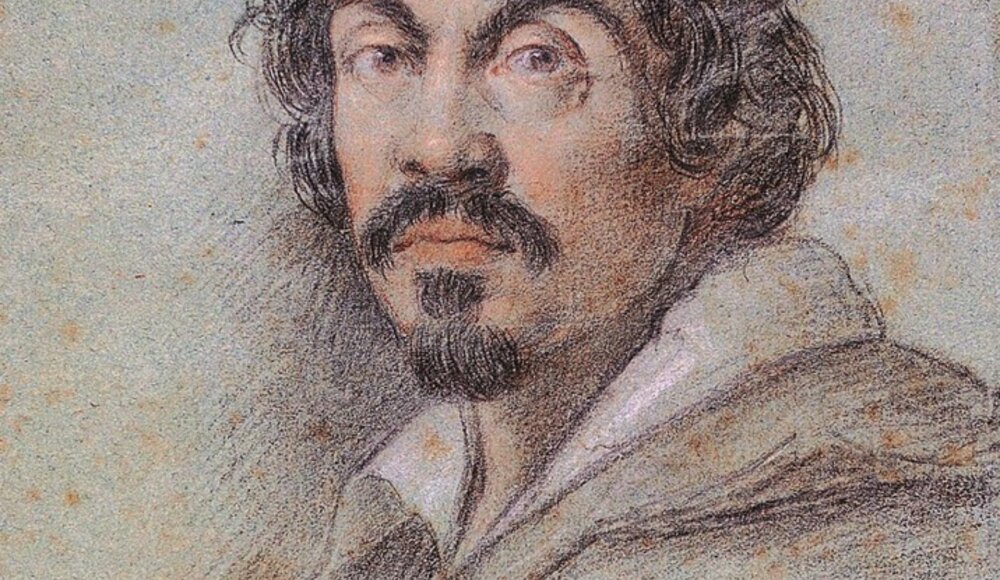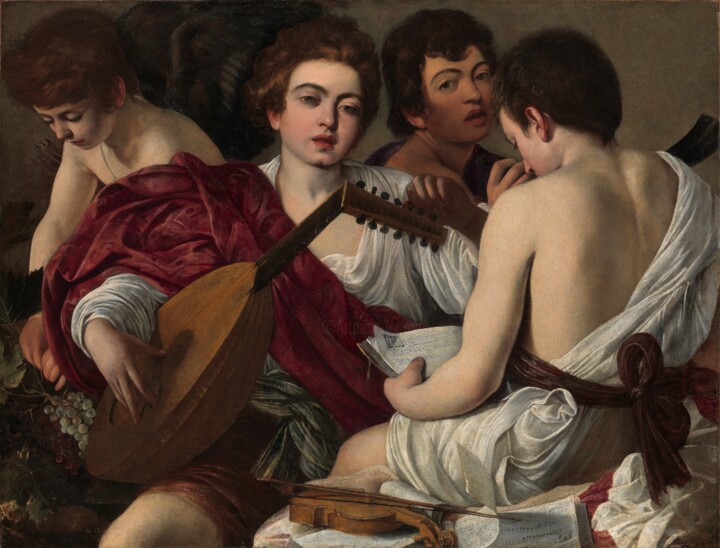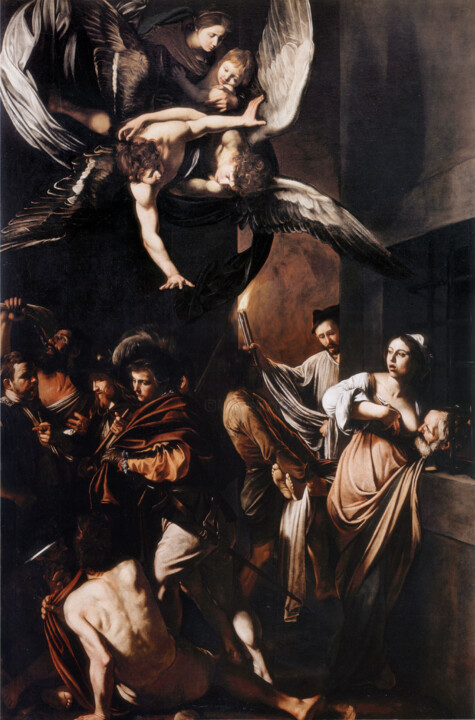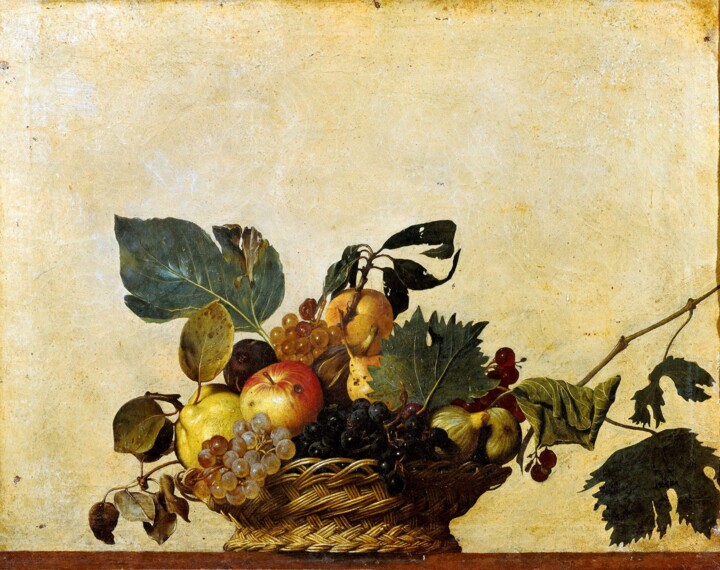 Portrait of Caravaggio by Ottavio Leoni, c. 1621. Black charcoal and pastels on blue paper, 23.4 × 16.3 cm. Florence: Marucelliana Library.
Portrait of Caravaggio by Ottavio Leoni, c. 1621. Black charcoal and pastels on blue paper, 23.4 × 16.3 cm. Florence: Marucelliana Library.
Who was Caravaggio?
Caravaggio, whose full name was Michelangelo Merisi da Caravaggio (1571-1610), was an Italian Baroque painter. He is known for his use of dramatic lighting and intense realism in his paintings, as well as for his tumultuous life and controversial personality.
Caravaggio's paintings often featured religious or mythological scenes, but he depicted them with a raw, gritty realism that was unprecedented in his time. His use of chiaroscuro, or the contrast between light and dark, created a sense of drama and depth that drew viewers into his paintings.
Despite his artistic talents, Caravaggio was also known for his violent temper and his involvement in various criminal activities. He was repeatedly arrested for assault and other offenses, and he was eventually forced to flee Rome after killing a man in a brawl.
Today, Caravaggio is considered one of the most important painters of the Baroque period, and his influence can be seen in the work of many later artists. His paintings continue to be admired for their realism, drama, and emotional intensity.
 Caravaggio, Basket of Fruit, 1597-1600. Oil on canvas, 46 × 64 cm. Milan: Pinacoteca Ambrosiano.
Caravaggio, Basket of Fruit, 1597-1600. Oil on canvas, 46 × 64 cm. Milan: Pinacoteca Ambrosiano.
Young Caravaggio (1571–1592)
Caravaggio was born on September 29, 1571, in the town of Milan in Lombardy, Italy. His father, Fermo Merisi, was a steward and architect for the local aristocracy, and his mother, Lucia Aratori, came from a well-respected family in Milan.
Caravaggio's early life is not well-documented, but it is believed that he began his artistic training in Milan as a teenager. In 1592, he moved to Rome, where he quickly established himself as a talented painter and gained the patronage of several prominent cardinals and noblemen.
During this time, Caravaggio began to develop the style for which he would become famous, using dramatic lighting and intense realism to create powerful and emotional paintings. He also began to attract controversy for his unconventional approach, which often included using lower-class models and depicting religious figures with a raw and sometimes shocking realism.
Despite these challenges, Caravaggio's reputation continued to grow, and by the end of the decade, he was one of the most sought-after painters in Rome. In 1599, he received a prestigious commission to paint two large altarpieces for the Contarelli Chapel in the Church of San Luigi dei Francesi, cementing his place as a leading artist of his time.
 Caravaggio, Young Sick Bacchus, 1593-1594. Oil on canvas, 94 × 119 cm. Rome: Borghese Gallery.
Caravaggio, Young Sick Bacchus, 1593-1594. Oil on canvas, 94 × 119 cm. Rome: Borghese Gallery.
Artistic training
Caravaggio's artistic training is not very well-documented, but it is believed that he started his career as an apprentice to the Lombard painter Simone Peterzano in Milan. Peterzano was a student of Titian and a follower of the Mannerist style, which was characterized by elongated forms, exaggerated poses, and elaborate ornamentation.
Caravaggio's early works show the influence of this style, but he soon developed his own approach to painting that emphasized realism and dramatic lighting. It is also possible that he learned from the naturalistic tradition of Northern European art, which was characterized by a strong attention to detail and a focus on everyday life.
Beyond his apprenticeship with Peterzano, it is not clear if Caravaggio had any formal training in the arts. However, he was known to have studied the works of Michelangelo, Raphael, and Leonardo da Vinci, as well as those of other contemporary artists. He also had a reputation for being a keen observer of life, and it is likely that he learned much of his technique by studying the world around him.
Despite the lack of a formal education, Caravaggio became one of the most important painters of the Baroque period, known for his bold use of light and shadow, his intense realism, and his highly dramatic compositions. His influence can be seen in the work of countless artists who followed in his footsteps, making him one of the most important figures in the history of Western art.
 Caravaggio, Shield with the head of Medusa, c. 1598. Oil on canvas, 60 × 55 cm. Florence: Uffizi Gallery.
Caravaggio, Shield with the head of Medusa, c. 1598. Oil on canvas, 60 × 55 cm. Florence: Uffizi Gallery.
Focus on the first Roman period (1592 and 1600)
Caravaggio arrived in Rome probably in the year 1592, at the age of around 21-22. At that time, Rome was the artistic and cultural center of Europe, attracting artists and intellectuals from all over the continent. Caravaggio was no exception, and he came to Rome in search of new opportunities and artistic inspiration.
At the time of his arrival, Caravaggio was still a relatively unknown artist, having only recently completed his apprenticeship with the Lombard painter Simone Peterzano in Milan. However, he was already beginning to develop his signature style, which emphasized realism, dramatic lighting, and intense emotional expression.
Upon his arrival in Rome, Caravaggio set up a workshop and began to produce a series of genre scenes and still lifes, such as "The Fortune Teller" and "The Cardsharps," which feature everyday people in everyday situations. These works quickly gained him a reputation as a skilled and innovative artist, and he began to attract the attention of wealthy patrons and powerful church officials.
In 1595, Caravaggio received his first major commission for a religious painting, "The Martyrdom of Saint Matthew," which was intended for the Contarelli Chapel in the Church of San Luigi dei Francesi. The painting was a massive success and established Caravaggio as one of the leading painters of his time.
Despite his success, Caravaggio was also a controversial figure during his time in Rome. He was known for his difficult personality, his violent temper, and his frequent run-ins with the law. Nevertheless, his innovative use of light and shadow and his intense emotional expression would go on to influence generations of artists, making him one of the most important figures of the Baroque era.
 Caravaggio, Boy with Basket of Fruit, 1593-1594. Oil on canvas, 74 × 78 cm. Rome: Borghese Gallery.
Caravaggio, Boy with Basket of Fruit, 1593-1594. Oil on canvas, 74 × 78 cm. Rome: Borghese Gallery.
Cardinal Del Monte
Cardinal Francesco Maria Del Monte was a powerful figure in Rome during the late 16th and early 17th centuries, and he played a significant role in Caravaggio's career. Del Monte was a patron of the arts and a collector of contemporary works, and he recognized Caravaggio's talent early on.
In the early 1590s, Del Monte became Caravaggio's most important patron, commissioning a series of works that would become some of the artist's most famous paintings. These works included "The Fortune Teller," "Bacchus," and "The Lute Player," all of which feature young men in various states of undress and were considered scandalous at the time.
Del Monte was also responsible for securing a number of important commissions for Caravaggio, including the "Martyrdom of Saint Matthew" for the Contarelli Chapel and the "Crucifixion of Saint Peter" for the Cerasi Chapel in the Church of Santa Maria del Popolo.
In addition to commissioning works, Del Monte also provided Caravaggio with financial and legal support during his time in Rome. When Caravaggio was involved in a number of scandals and legal disputes Del Monte intervened on his behalf, helping to ensure that he was not punished too severely.
Despite their close relationship, however, Del Monte and Caravaggio eventually had a falling out, and Caravaggio left Rome in 1606, never to return. Nevertheless, Del Monte's support during Caravaggio's early years in Rome played a significant role in his success and helped to establish him as one of the most important artists of the Baroque era.
 Caravaggio, Bacchus, 1596-1597. Oil on canvas, 95 × 85 cm. Florence: Uffizi.
Caravaggio, Bacchus, 1596-1597. Oil on canvas, 95 × 85 cm. Florence: Uffizi.
What are the best known works that Caravaggio made between 1592 and 1600?
 Michelagelo, The fortune teller, c.1594. 115 cm × 150 cm. Rome: Capitoline Museums.
Michelagelo, The fortune teller, c.1594. 115 cm × 150 cm. Rome: Capitoline Museums.
- "The Fortune Teller" (1594-1595): A painting of a young man having his fortune told by a gypsy woman. This work is known for its use of dramatic lighting and realistic portrayal of everyday people.
- "Bacchus" (1596-1597): A painting of the Roman god of wine, depicted as a young man holding a goblet of wine and a bowl of fruit. This work is known for its sensual and naturalistic depiction of the human form.

Michelagelo, The Cardsharps, c. 1594. 94 cm × 131 cm. Fort Worth: Kimbell Art Museum.
- "The Cardsharps" (1594-1595): A painting of two young men playing cards, with one cheating the other. This work is known for its realism and its depiction of the seedy side of everyday life.
 Michelagelo, The Calling of Saint Matthew, 1599–1600. Oil on canvas, 322 cm × 340 cm. Rome: San Luigi dei Fracesi.
Michelagelo, The Calling of Saint Matthew, 1599–1600. Oil on canvas, 322 cm × 340 cm. Rome: San Luigi dei Fracesi.
- "The Calling of Saint Matthew" (1599-1600): A painting of the Biblical figure Saint Matthew, depicted as a tax collector, being called by Jesus to follow him. This work is known for its use of dramatic lighting and its realistic portrayal of everyday people.
 Michelagelo, The Martyrdom of Saint Matthew, 1599–1600. Oil on canvas, 323 cm × 343 cm. Rome: San Luigi dei Fracesi.
Michelagelo, The Martyrdom of Saint Matthew, 1599–1600. Oil on canvas, 323 cm × 343 cm. Rome: San Luigi dei Fracesi.
- "The Martyrdom of Saint Matthew" (1599-1600): A large altarpiece commissioned for the Contarelli Chapel in the Church of San Luigi dei Francesi. This work is known for its dramatic composition and its depiction of violence and suffering.
Roman works from 1600 onward
Caravaggio's Roman works from 1600 onward were created during a period of personal and professional turmoil, marked by legal troubles and financial difficulties. Nevertheless, he continued to create some of his most iconic works during this time, including:
 Caravaggio, The Crucifixion of Saint Peter, 1600-1601. Oil on canvas, 230×175 cm. Rome: Basilica di Santa Maria del Popolo.
Caravaggio, The Crucifixion of Saint Peter, 1600-1601. Oil on canvas, 230×175 cm. Rome: Basilica di Santa Maria del Popolo.
- "The Crucifixion of Saint Peter" (1600-1601): A large altarpiece commissioned for the Cerasi Chapel in the Church of Santa Maria del Popolo. The painting depicts the martyrdom of Saint Peter, with the saint crucified upside-down and surrounded by Roman soldiers. This work is known for its use of dramatic lighting and its powerful emotional impact.
 Caravaggio, The Conversion of Saint Paul , 1600/1601. Oil on wood, 237 cm × 189 cm. Rome: Odescalchi Balbi Collection.
Caravaggio, The Conversion of Saint Paul , 1600/1601. Oil on wood, 237 cm × 189 cm. Rome: Odescalchi Balbi Collection.
- "The Conversion of Saint Paul" (1600-1601): A painting of the Biblical figure Saint Paul, who is shown falling from his horse and being blinded by a bright light, a symbol of his conversion to Christianity. This work is known for its dramatic composition and its emphasis on emotional expression.
 Caravaggio, The Entombment of Christ, 1603–1604. Oil on canvas, 300 cm × 203 cm. Vatican City: Pinacoteca Vaticana.
Caravaggio, The Entombment of Christ, 1603–1604. Oil on canvas, 300 cm × 203 cm. Vatican City: Pinacoteca Vaticana.
- "The Entombment of Christ" (1603-1604): A painting of the dead body of Christ being placed in his tomb by his followers. This work is known for its powerful emotional impact and its realistic portrayal of the human body.
 Caravaggio, The Madonna of the Serpent, 1605. Oil on canvas, 292 × 211 cm. Rome: Galleria Borghese.
Caravaggio, The Madonna of the Serpent, 1605. Oil on canvas, 292 × 211 cm. Rome: Galleria Borghese.
- "The Madonna of the Serpent" (1605-1606): A painting of the Virgin Mary holding the baby Jesus, with a serpent coiled around the infant's leg. This work is known for its sensual and naturalistic depiction of the human form.
 Michelagelo, The Martyrdom of Saint Ursula, 1610. Oil on canvas, 140.5 cm × 170.5 cm. Naples: Palazzo Zevallos Stigliano.
Michelagelo, The Martyrdom of Saint Ursula, 1610. Oil on canvas, 140.5 cm × 170.5 cm. Naples: Palazzo Zevallos Stigliano.
- "The Martyrdom of Saint Ursula" (1610): A painting of the saint and her companions being killed by the Huns. This work is known for its violent and bloody depiction of the scene.
 Caravaggio, Narcissus, 1597-1599. Oil on canvas, 112×92 cm. Rome: Galleria Nazionale d'Arte Antica - Palazzo Barberini.
Caravaggio, Narcissus, 1597-1599. Oil on canvas, 112×92 cm. Rome: Galleria Nazionale d'Arte Antica - Palazzo Barberini.
The Tomassoni murder and the escape from Rome
Caravaggio’s life was marked by controversy and violence, including his involvement in the murder of a man named Ranuccio Tomassoni.
The incident occurred in May 1606, when Caravaggio was living in Rome and had become embroiled in a dispute with Tomassoni, a fellow artist. According to accounts from the time, the two men had argued over a debt that Tomassoni owed Caravaggio, and the altercation turned physical.
Some reports suggest that Caravaggio may have been carrying a sword, and in the ensuing scuffle, Tomassoni was mortally wounded. Caravaggio fled the scene, fearing retribution from Tomassoni's powerful family, and went into hiding.
The incident sent shockwaves through the artistic community in Rome, with many of Caravaggio's contemporaries expressing shock and dismay at his violent behavior. But the artist himself seemed largely unaffected, continuing to produce works of great beauty and emotional depth.
It was not until several months later that Caravaggio was finally arrested and charged with murder. He was imprisoned for several weeks while awaiting trial, during which time he reportedly suffered from depression and anxiety.
In the end, Caravaggio was convicted of murder in absentia, as he had fled Rome once again before the trial could begin. He spent the rest of his life in exile, moving from city to city and producing some of his most celebrated works.
The story of Caravaggio and the Tomassoni murder is a reminder of the complex and often turbulent lives of many great artists. While we may admire their works, we must also recognize the struggles and challenges they faced in their personal lives, and the impact those struggles had on their art.
 Caravaggio, David with the head of Goliath, 1609-1610. Oil on canvas, 125×100 cm. Rome: Galleria Borghese.
Caravaggio, David with the head of Goliath, 1609-1610. Oil on canvas, 125×100 cm. Rome: Galleria Borghese.
Caravaggio's exile years
After the death of Ranuccio Tomassoni, Caravaggio fled from Rome and began a life of exile. Over the next several years, he moved from city to city throughout Italy, seeking refuge and continuing to create his masterful works of art.
During this time, Caravaggio faced numerous challenges and difficulties. He was constantly on the move, never able to settle in one place for long, and often struggled to find patrons who were willing to support his work. He was also plagued by personal demons, including a volatile temper and a tendency towards self-destructive behavior.
Despite these challenges, Caravaggio's exile years were some of the most productive of his career. He produced many of his most famous works during this period, including "The Beheading of Saint John the Baptist" and "Flagellation of Christ."
In many ways, Caravaggio's exile years represented a period of artistic and personal growth for the troubled artist. He continued to refine his unique style, exploring new techniques and pushing the boundaries of what was possible with paint and canvas.
But Caravaggio's exile was not without its consequences. His reputation as a violent and unpredictable artist continued to follow him, and he often found himself embroiled in conflicts with both patrons and fellow artists.
In 1610, Caravaggio received a pardon from the pope and was invited back to Rome. But his return was short-lived, as the artist died shortly thereafter.
 Caravaggio, Judith and Holofernes, c. 1600-1602. Oil on canvas, 145×195 cm. Rome: National Galleries of Ancient Art, Palazzo Barberini.
Caravaggio, Judith and Holofernes, c. 1600-1602. Oil on canvas, 145×195 cm. Rome: National Galleries of Ancient Art, Palazzo Barberini.
The end of days
So, we get to July of 1610, when the powerful Colonna family seems to have helped make it look like the request for a pardon was about to be given.
Caravaggio went out to sea again on a felucca going from Naples to Porto Ercole, which was part of the State of the Spanish Garrisons at the time. The painter brought three very valuable paintings with him: St. John the Baptist, St. John the Baptist Lying Down, and Magdalene in Ecstasy. He planned to give them to Cardinal Scipione Borghese, the nephew of Pope Paul V, as a way to thank him for his interest.
When Caravaggio got to Palo, which is about 40 kilometers from Rome, he was stopped and put in jail for two days. We don't know why he was arrested or why he was let go. He may have been confused for a criminal, but we don't know for sure. But the time it took to get him out of jail was too long to hope to find the felucca, which had already set sail again with its valuable cargo.
Caravaggio tried to get his paintings back by going to Porto Ercole. When he got there, he was tired and couldn't find the felucca. He couldn't go on with his trip because he got sick and died in Porto Ercole on July 18, 1610, at the age of 39.
One of the many mysteries that have not yet been answered is what happened to the three paintings Caravaggio had with him. Scipione Borghese, who they were meant for, the Marchesa Costanza Colonna, the Prior of Capua of the Knights of the Order of Malta, and Pedro Fernández de Castro, Count of Lemos and viceroy of Naples from 1610 to 1616, all claimed them after the painter died.
Scipione Borghese only got one canvas, which is the St. John that is now in the Galleria Borghese in Rome. The second St. John, which is St. John the Baptist lying down and is now in a private collection in Munich, probably went to the Count of Lemos, while the Marquise Costanza Colonna got La Maddalena in Ecstasy, which is now in a private collection.
Some people say that Caravaggio's arrest in Palo was planned and that the famous felucca never made it to Porto Ercole. Instead, it went back to Naples, where the marquise Costanza Colonna was waiting for it.
Today, Caravaggio's legacy lives on through his timeless works of art, which continue to inspire and captivate audiences around the world. His influence can be seen in the works of countless artists who have been inspired by his innovative techniques and dramatic style.
Despite his turbulent and often controversial life, Caravaggio remains one of the most important and influential artists in the history of art, and his death only serves to underscore the enduring power of his art and the lasting impact he has had on the world of art and culture.


 Selena Mattei
Selena Mattei





